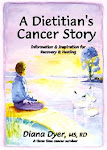In response to the comments to my 7/18 postings about the WHEL Study's results, I want to add yet a few additional thoughts. Over the past 10-12 years, I have met numerous cancer researchers who, after hearing me speak about my wide and diverse approach to recovery after cancer, have told me that they wished that they were studying what I and other successful survivors have actually been doing to optimize our odds for long-term survival (all of us often are or at least feel like N=1, i.e., case studies, not validated research studies from which recommendations for other people can be made).
There is a relatively new study being funded by the National Cancer Institute called the Pathways Study, being conducted by the Kaiser Permanente of Northern California that aims to examine the effects of modifiable factors associated with recurrence and survival for breast cancer. Specifically, they will be collecting extensive data on: 1) lifestyle factors such as diet, physical activity, quality of life, and use of complementary and alternative therapies and 2) many genetic factors in the breast tumors. Essentially all newly diagnosed breast cancer patients within that health care system will be offered a chance to be a part of this vital and important prospective study as soon after diagnosis as possible. The entry point into the Pathways Study is an important difference and potential benefit of this study, as most research studying lifestyle aspects of cancer survival wait until after treatment is completed to begin the observation or intervention. (you can click on the title to this posting to link to the full description of the Pathways Study.)
Just as we now know that combining more than one healthy food in a meal (soy and green tea for instance) produce anti-cancer effects that are larger than using either food alone, it is very likely that combining multiple different "self-help" strategies at one time will produce benefits that are larger than using any one alone. (in fact that is the very reason why a typical chemotherapy protocol usually consists of several different types of drugs)
Benefit from a achieving a combination of healthy lifestyle behaviors is exactly what was seen when evaluating data from subgroups within the control arm of the WHEL study. The relatively small group of women who consumed 5+ servings of fruits and vegetables daily PLUS exercised ~30 minutes daily were the only sub-group who experienced a 50% reduction in recurrence. This is a powerful statistic and a powerful message. The principle investigator for the Pathways Study (Larry Kushi, PhD) and I have talked about this concept in the past. I am very hopeful that this new study will add to the picture and ultimately to the recommendations of what each person can do on an individual basis to improve the odds of their own survival.
So, I still recommend eating a wide variety of fruits and veggies (especially dark green leafy veggies, not just peas, corn, orange juice and bananas!) and taking a daily brisk hike!
I always remember that I wear two hats - that of a cancer survivor struggling in the trenches along with millions of others plus that of a health care professional who takes leading by example very seriously. Today my dog and I have already had one brisk 45 minute walk. I am wearing my Life is Good t-shirt that says "Walk on", and I used my wok (which I keep handy right by my stove-top) to make a quick and simple stir-fry for lunch using firm tofu, snap peas, sunflower sprouts, red cabbage, spicy green mustard greens, fresh garlic, and curry powder. :-)
Walk-wok! :-)
Diana Dyer, MS, RD
Subscribe to:
Post Comments (Atom)


No comments:
Post a Comment